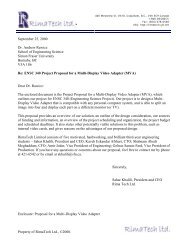Fleksibilni Internet servisi na bazi kontrole kašnjenja i
Fleksibilni Internet servisi na bazi kontrole kašnjenja i
Fleksibilni Internet servisi na bazi kontrole kašnjenja i
Create successful ePaper yourself
Turn your PDF publications into a flip-book with our unique Google optimized e-Paper software.
sensitive flows into two different queues and assignees service rates to these queues that<br />
will ensure that the ratio of average queuing delays for throughput-sensitive and delay-<br />
sensitive classes is equal to the ratio specified by a network operator. In Section 5, we<br />
present an ideal rate assignment strategy for proportio<strong>na</strong>l delay differentiation <strong>na</strong>med<br />
Optimized BPR (BPR + ) in order to evaluate the performance of BPR scheduler. BPR +<br />
[38] is an extension of BPR. It employs more complete information about backlogged<br />
traffic to assign service rates to TS and DS queues in order to more precisely approximate<br />
the specified delay ratio δ. Even though BPR + is to complex to warrant practical<br />
implementations, it is useful as a benchmark for evaluating other possible rate assignment<br />
strategies for proportio<strong>na</strong>l delay differentiation. Detailed description and performance<br />
comparison of BPR + and BPR is given in Section 5.<br />
The second objective is accomplished using a new algorithm, <strong>na</strong>med Packet Loss<br />
Controller (PLC). Since BPR scheduler is work-conserving, average queuing delay is<br />
identical as in the case of FCFS scheduling employed in a best-effort network. If the total<br />
number of packets accepted in the buffer is maintained to be the same as it would be in a<br />
best-effort network, lower delay for delay-sensitive packets can be achieved only by<br />
increasing the queuing delay for throughput-sensitive packets. Since throughput of a TCP<br />
flow depends on its round-trip time, introduction of low-delay service for delay-sensitive<br />
class will deteriorate the performance of throughput-sensitive applications that use TCP<br />
as a transport protocol. The PLC controller is used to overcome this problem by<br />
protecting the throughput of TCP flows. It guarantees that the TCP throughput in the<br />
presence of delay differentiation is not lower than in a best-effort network. PLC<br />
27






